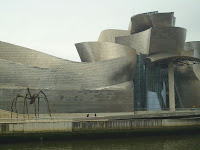
 Our next outing was to the industrial city of Bilbao. The waterfront has been rebuilt in recent years and this is where Frank Gherry designed and built the Guggenheim Museum. It is more an art gallery than a museum and I was not too interested in the exhibits housed there at the moment. The building, however, is pretty impressive. From the opposite bank of the river it looks like a great silver boat. Indoors it is light and airy with lots of exposed steel and concrete. I also loved "Puppy", a huge floral dog set just outside the upper entrance.
Our next outing was to the industrial city of Bilbao. The waterfront has been rebuilt in recent years and this is where Frank Gherry designed and built the Guggenheim Museum. It is more an art gallery than a museum and I was not too interested in the exhibits housed there at the moment. The building, however, is pretty impressive. From the opposite bank of the river it looks like a great silver boat. Indoors it is light and airy with lots of exposed steel and concrete. I also loved "Puppy", a huge floral dog set just outside the upper entrance.













